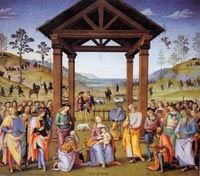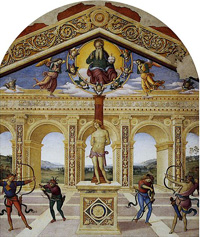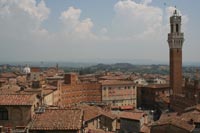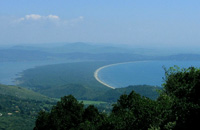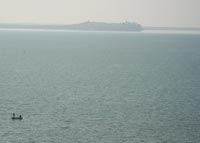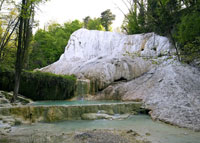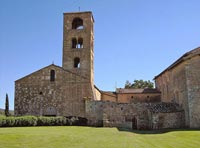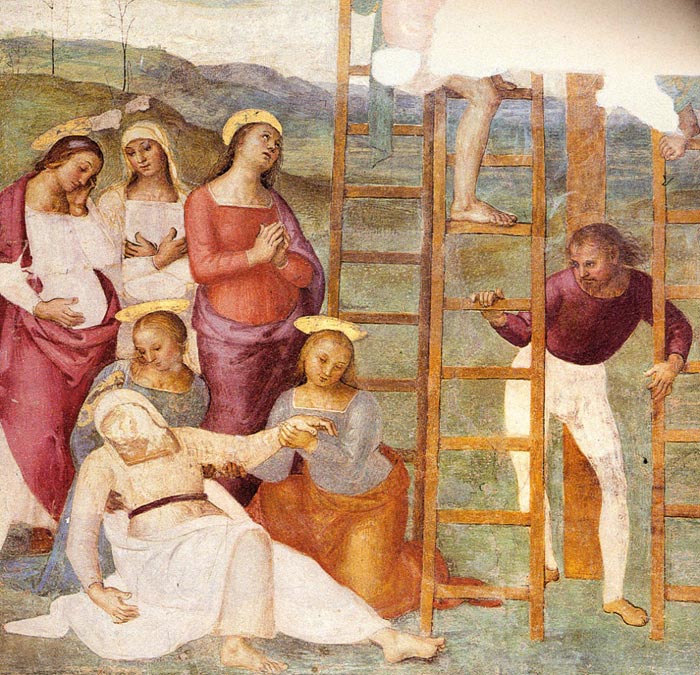 |
|
Il Perugino, Deposizione della Croce |
|
Pietro Perugino and the lake Trasimeno scenary |
| Pietro Perugino was born in 1446 in Città della Pieve, Umbria. He was the son of Cristoforo Vannucci; his nickname characterizes him as from Perugia, the chief city of Umbria. By the age of nine, Pietro was articled to a master, a painter at Perugia. Benedetto Bonfigli is generally surmised to be the man; if he is rejected as not being above mediocrity, either Fiorenzo di Lorenzo or Niccolò da Foligno may possibly have been the man.
Pietro painted at Arezzo, then moved to Florence. The date of this first Florentine sojourn is by no means settled; some make it as early as 1470, others push the date to 1479. According to Vasari, he apprenticed in the atelier of Andrea del Verrocchio alongside Leonardo de Vinci. He may have learned perspective from Piero della Francesca. In 1472 he must have completed his apprenticeship, for he was enrolled as a painter in the confraternity of St Luke. Perugino was one of the earliest Italian practitioners of oil painting. Some of his early works were extensive frescoes for the convent of the Ingesati fathers, destroyed during the siege of Florence, 1537; he produced for them also many cartoons, which they executed with brilliant effect in stained glass. A good specimen of his early style in tempera is the tondo (circular picture) in the Louvre of the Virgin and Child Enthroned between Saints. Perugino returned from Florence to Perugia, where his Florentine training showed in the Adoration of the Magi for the church of Santa Maria dei Servi (ca 1476). In about 1480, he was called to Rome to fresco panels for the Sistine Chapel walls by Sixtus IV including Moses and Zipporah (often attributed to Luca Signorelli), the Baptism of Christ, and Christ Giving the Keys to Peter (illustration, right). Pinturicchio accompanied Perugino to Rome, and was made his partner, receiving a third of the profits. He may have done some of the Zipporah subject. The Sistine frescoes were the major high renaissance Patronage in Rome. The altar wall was also painted with the Assumption, the Nativity, and Moses in the Bulrushes. These works were later ruthlessly destroyed to make a space for Michelangelo Last Judgement, Perugino, age forty, left Rome after completion of the Sistine Chapel work in 1486, and by autumn was in Florence. Here he figures by no means advantageously in a criminal court. In July 1487 he and another Perugian painter named Aulista di Angelo were convicted, on their own confession, of having in December waylaid with staves someone (the name does not appear) in the streets near Pietro Maggiore. Perugino merely intended assault and battery, but Aulista meant to commit murder. The more illustrious culprit, guilty of the lesser offence, was fined ten gold florins, and the other was exiled for life. Between 1486 and 1499 Perugino worked chiefly in Florence, making one journey to Rome and several to Perugia, where he may have maintained a second studio. He had an established studio in Florence, and received a great number of commissions. His Pietà (1495) in the Palazzo Pitti is an uncharacteristically stark work that avoids Perugino's sometimes too easy sentimental piety. In 1499 the guild of the cambio (money-changers or bankers) of Perugia asked him to decorate their audience-hall. This extensive scheme, which may have been finished by 1500, comprised the painting of the vault with the seven planets and the signs of the zodiac (Perugino being responsible for the designs and his pupils most probably for the execution) and the representation on the walls of two sacred subjects: the Nativity and Transfiguration; in addition, the Eternal Father, the cardinal virtues of Justice, Prudence, Temperance and Fortitude, Cato as the emblem of wisdom, and numerous life-sized figures of classic worthies, prophets and sibyls figured in the program. On the mid-pilaster of the hall Perugino placed his own portrait in bust-form . It is probable that Raphael, who in boyhood, towards 1496, had been placed by his uncles under the tuition of Perugino, bore a hand in the work of the vaulting. About this time or a few years later Perugino was made one of the priors of Perugia in 1501. Michelangelo, twenty-five years of age in 1500, following after and distancing Leonardo da Vinci, was opening men's eyes and minds to possibilities of achievement as yet unsurmised. Michelangelo on one occasion, in company, he told Perugino to his face that he was a bungler in art (goffo nell arte): Vannucci brought an action for defamation of character, unsuccessfully. Put on his mettle by this mortifying transaction, he determined to show what he could do, and he produced the masterpiece of the Madonna and Saints for the Certosa of Pavia, now disassembled and scattered among museums: the only portion in the Certosa is God the Father with cherubim. An Annunciation has disappeared; three panels, the Virgin adoring the infant Christ, St Michael, and St Raphael with Tobias, are among the treasures of the National Gallery, London. This was succeeded in 1505 by an Assumption, in the Cappella dei Rabatta, in the church of the Servi in Florence. The painting may have been executed chiefly by a pupil, and was at any rate a failure: it was much decried; Perugino lost his students; and towards 1506 he once more and finally abandoned Florence, going to Perugia, and thence in a year or two to Rome. Pope Julius II had summoned Perugino to paint the Stanza of the Incendio del Borgo in the Vatican City; but he soon preferred a younger competitor, Raphael, who had been trained by Perugino; and Vannucci, after painting the ceiling with figures of God the Father in different glories, in five medallion-subjects, retired from Rome to Perugia from 1512. Among his latest works, many of which decline into repetitious studio routine, one of the best is the extensive altarpiece (painted between 1512 and 1517) of the church of San Agostino in Perugia, also now dispersed. Perugino's last frescoes were painted for the church of the Madonna delle Lacrime in Trevi (1521, signed and dated), the monastery of Sant'Agnese in Perugia, and in 1522 for the church of Castello di Fortignano. Both series have disappeared from their places, the second being now in the Victoria and Albert Museum. Pietro Perugino was still at Fontignano in 1524 when he died of the the plague. Like other plague victims, he was hastily buried in an unconsecrated field, the precise spot now unknown. |
Renaissance and Mannerism Painting in Città della Pieve-Paciano-Panicale Castiglione del Lago. |
| A guide to the works of Pietro Perugino in the area, pathways to explore the artistic and cultural heritage of the land of Lake Trasimeno. Most of his Umbrian paintings are in Perugia but there are many of his works in the small towns of Umbria. Pietro Vannucci, known as «Il Perugino», was inspired to paint his celebrated sceneries by what he saw in the area that goes from Città della Pieve towards Lake Trasimeno and the Valdichiana. In order to truly enjoy these scenes one must follow along the road which from Città della Pieve goes to Paciano, Panicale and Castiglione del Lago, marked by the masterpieces of the Maestro and his School. It is a particularly sentimental route immersed in a scenery of gently rolling hills with marvellous views of the Lake Trasimeno. Vannucci did not paint actual landscapes, but the depicted scenes in his masterpieces along this route underline the close relationship between nature and artistic creation. The route also underlines the creation of paintings which can be ascribed to the Tuscan-Roman school of Mannerism. Information | Servizio Turistico Territoriale del Trasimeno | Tel. +39 0759652484 :: Fax +39 0759652763 | E-mail: urat@lagotrasimeno.net An all inclusive ticket, available at any one of the ticket sales points, is valid for entrance to all of the points of interest. A guidebook of the route is also available. |
|||
| Born around the year 1450 in what was then Castel della Pieve, situated on the border between territory governed by Perugia and that governed by Siena, Il Perugino, as he came to be known, underwent his artistic formation between Arezzo and Florence, the environment dominated by Piero della Francesca and the Verrocchio studio. Pietro Vannucci gets his nickname Il Perugino from the Florentines in January of 1501 when he opened his own atelier in Perugia. In those days being born in Castel della Pieve did not necessarily mean one was Umbrian, or even Perugian. Castel della Pieve has its origins in the 7th century as an outpost of the Tuscia Longobarda in their defence against Byzantine Perugia, and by whom they in fact were finally conquered in 1188. And so Perugia, a pro-papal city state, opposed the anti-papal stance of the Castel della Pieve residents who looked to Siena, the most powerful pro-Empire city state of central Italy, for alliance and to whom it was also tied by the numerous roads which connected them, such as the via Franchigena. Castel della Pieve was also on another important route: that of the via dell’Alpe di Serra, which goes from Forlì into the Arno valley and Arezzo. From here, following along the eastern side of the Valdichiana, one gained Castiglion Fiorentino, Cortona, the hills of Castiglione del lago, Castel della Pieve, Orvieto and Montefiascone, where it then met up with the via Franchigena. It is important to stress that Pietro Perugino, during his many journeys to Arezzo and Florence, often used that route which in the stretch between Castel della Pieve and Cortona, from the soft rolling hills, had magnificent views of the Lake Trasimeno and the Valdichiana. It was this exact scenery which inspired so many of his celebrated backdrops. The idea of scenery as backdrop comes alive with Il Perugino, Pinturicchio and the young Raffaello: in fact it becomes an element of coherence and of unity for the entire painted scene, fusing the emotional tones of the figures and their placement in space, giving it a double lyrical effect of immersion and distance”. In his compositions, with its prominent thoughtful figures inspired by classical statues and the scenic backdrop with their noble lines that fade away into infinity, a sentimental dimension is created which suggests the harmonic presence of God in His universe. To fully appreciate it one should follow that same, still somewhat secretive, route which goes from Città della Pieve towards Paciano, Panicale and Castiglion del lago, and is dotted by the masterpieces of the Maestro and his School. |
|||
| Città della Pieve |
|||
| In Città della Pieve one can admire:
Il Battesimo di Cristo (The Baptism of Christ) – In the Cathedral,
|
|
||
From Città della Pieve, going towards Paciano, on the road which leads to Moiano the grand panorama over the Trasimeno Lake and the Valdichiana opens up, bordered by the soft rolling hills of Paciano to the right and Chiusi to the left. |
|||
| Fontignano is another town on the Perugino trail. The place that captures the true essence of Perugino is the small chapel at Fontignano where he died, a victim of the plague, still painting at the age of about 80. From Fontignano one contiues on to Perugia where there are many Perugino painting in the National Gallery and elsewhere. The fresco of the Nativity, in the National Gallery, London, comes from Fontignano and is generally supposed to be Perugino's last work. |
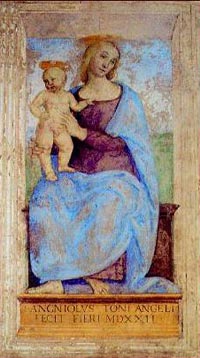 La Madonna col Bambino |
||
|
 |
||||
|
||||
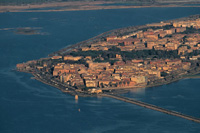 |
||||
Podere Santa Pia |
Siena, Piazza del Campo |
Orbetello | ||
Tombolo di Feniglia |
Lago Trasimeno |
Bagni San Filippo |
||
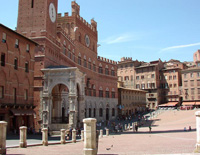 |
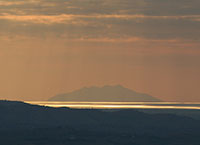 |
|||
Sovicille |
Siena, Palazzo Publicco |
Sunsets in Tuscany |
||
 |
||||
| The valley plainbelow Santa Pia is a classic example of the Tuscan landscape, with endless hills, cypresses, wine, corn fields and streams, offering splendid views up to the Tyrrhenian coast and Montecristo |
||||

